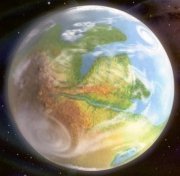The body most commonly thought of in association with terraforming is Mars. There are several reasons Mars is looked upon favorably. The gravity on Mars is about 0.38 g, compared to 1 g on Earth. It is believed that humans could live in such a gravity without any side effects like bone shrinkage. The day on Mars is about 24.5 hours, compared to 24 hours on Earth. This means that there wouldn't be any agricultural problems relating to day length. There are large quantities of rust (FE203) which would allow production of iron, further enabling a colony on Mars to be independent of Earth. Mars has water in ice form which could be melted for use, and the soil is rich in necessary minerals.

image courtesy of: www.nineplanets.org

One artist's idea of what Mars may look like after terraforming.
image courtesy of: http://www.redcolony.com/intro/index3.html artists: James Graham and Kandis Elliot